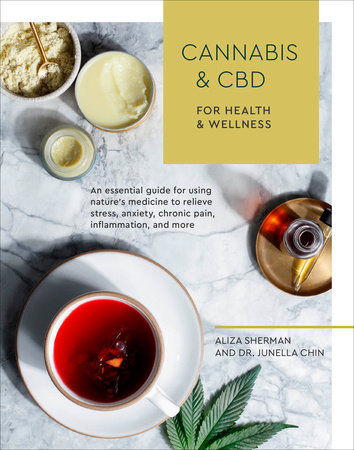Introduction
We’re here to tell you that cannabis is medicine. The anecdotal evidence gathered about the therapeutic benefits of cannabis is overwhelmingly positive. Research on cannabis—including cannabidiol, or CBD, which is contained within cannabis—is being conducted in many countries, with some research even taking place in the United States. The results are promising and support claims that cannabis can be used to reduce inflammation, relieve pain, and help people suffering from conditions ranging from epilepsy and Tourette’s syndrome to Crohn’s disease, multiple sclerosis, and rheumatoid arthritis.
And yet, in the United States, cannabis is still federally illegal, and many of us are nervous about looking into its health benefits. Did you look over your shoulder when you pulled this book from the shelf at your local bookstore or library? Or did you buy it online to avoid prying or disapproving eyes? If you did, you’re not alone.
Many of us were taught to believe that cannabis is bad, unsavory, and dangerous. We might associate pot with stoners, weed with hippies, and marijuana with criminals. Luckily, attitudes about cannabis, and CBD in particular, are changing. According to the Pew Research Center, 62 percent of Americans say the use of cannabis should be legalized. You’re probably seeing more human interest and news stories about cannabis and CBD in mainstream media about everything from cannabis-infused dinners to CBD beauty products. Depending on the legal status of cannabis and CBD in your city or state, you may be feeling more confident about exploring one or both for health and wellness. If you’re living in a state that has not yet legalized cannabis, you can still do your homework and get ready for when your state does legalize or when you are visiting an adult-use (recreationally legal) state.
Cannabis can be used, with proper guidance from a medical professional, to replace pharmaceutical medications such as antianxiety drugs, SSRIs for depression, and opioids to address pain.
If you live in a state where physicians are not allowed to recommend cannabis, look online for naturopathic physicians or holistic nurses who may be open to recommending more alternative forms of medicine, or herbalists who are well versed in plant medicine. Also check the internet for services such as cannabis counseling and review the credentials of the counselors. Some nutritionists and other wellness professionals now offer cannabis consulting services. Always be very careful before substituting any prescribed medications with cannabis or CBD.
We both came to cannabis as women who were experiencing debilitating pain but were still plagued with fear and doubt about using it. We both changed our minds about cannabis over time because it helped us.
Our goal with this book is to help remove the remaining stigma associated with cannabis so that other people, like you, can gain health and wellness benefits from this ancient medicinal plant. We’ll provide tips and guidelines so you can begin using cannabis and CBD on your own, although we recommend that you see a medical care provider or a cannabis consultant for the most upto-date information tailored to your specific needs. First, let us explain what brought us to cannabis.
JUNELLA’S STORY
At fifteen years old, I was diagnosed with ankylosing spondylitis (AS), a progressive type of arthritis that affects the spine, pelvis, hips, and back and causes extreme stiffness and nerve pain.
I spent my younger years trying conventional treatments— epidurals, narcotics, muscle relaxants, acupuncture, physical therapy—but the pain was unrelenting. By the time I got to medical school in San Francisco, I was having difficulty standing for long periods in the operating room. One of the attending physicians saw this and asked me about it. I told him I had AS but that I couldn’t take the meds I needed for relief while doing rounds or while attending a four-hour hip-replacement surgery because they made me drowsy and foggy.
Here I was in a hospital surrounded by great medical minds, but I was disheartened to find nothing could help my condition. The attending physician pulled me aside and handed me a bottle containing a tincture. “This is marijuana,” he told me, “but it won’t make you high.”
He didn’t call it CBD oil. He just said it was a different type of cannabis plant. I was mortified but desperate. As a medical student, training to be a doctor, my first thought was, “You are offering me pot? You want to make me a drug addict?” The little brown dropper bottle smelled like a combination of alcohol, wet dog, and grass, and I didn’t know what to think. To my amazement, the tincture worked very well. The pain and inflammation of my arthritis decreased dramatically, my ankylosing spondylitis stopped progressing, and my musculoskeletal health improved.
Even though California legalized medical marijuana in 1996, I didn’t dare tell anyone I was using it. I was a young physician and didn’t want to jeopardize my career. But once I got my health back, I decided to learn more about cannabis and how it helps manage pain and improve people’s overall health and wellness.
Having suffered in pain for so long, I know what it feels like to say to your doctor, “I’ve tried everything and nothing has helped.”
ALIZA’S STORY
When I first heard about cannabis being used for nonaddictive pain relief and insomnia relief in 2016, my first thought was, “If it is so effective, then why is it federally illegal?” I, like many people, bought into the idea that cannabis was dangerous and was made illegal to protect us all. Even though around seven states had already legalized cannabis by the time I began researching it for its therapeutic benefits, I was afraid to try it. At the same time, I was hopeful it could work for me.
After enduring two frozen shoulders and a few years of physical therapy in my late forties, by my early fifties I was in near-constant neck pain that my doctors attributed to years of computer use. The pain was keeping me up at night and limiting my mobility. I knew I needed to do something to address it when I couldn’t turn my head while driving to look while changing lanes.
I also felt like a ticking time bomb, ready to explode from sleep deprivation and frazzled nerves. Despite my health issues, it took a while for me to regard cannabis as alternative medicine that
could work alongside the homeopathy, chiropractic care, and acupuncture that I frequently turned to for pain management.
When I finally mustered the courage to try cannabis one night, the first thing I did was ground some indica flower (a variety of cannabis that produces relaxing effects) I purchased at a legal cannabis shop and tried vaping it (inhaling vapor versus smoke) with a vape pen. I immediately felt the acute pain in my neck subside after consuming only a small amount. For the first time in over a year, I slept through the night and woke up clearheaded and rested.
Once I experienced cannabis as effective medicine that worked without negative side effects, I knew I had to learn more about it and hopefully help others in the process. I am still cautious about using cannabis and even talking about it, but the more I hear from people that cannabis is helping them and changing their lives for the better, the more I know I’m doing the right thing.
IN THIS BOOK
Our goal is to guide you through your cannabis wellness journey or to help you guide a loved one with confidence. We learned over time, through our personal experiences and by doing our homework, that our fears about cannabis were unfounded. In chapter 1, we give a brief history of cannabis, outline why and how cannabis was vilified, and shed some light on how possessing and using a versatile medicinal plant became a crime.
You don’t have to be a scientist or doctor to understand the science behind why cannabis is effective medicine. In chapters 2 through 5, we break down the elements of the cannabis plant and how they interact with our bodies, often drawing on scientific studies from countries such as Canada, Spain, the Netherlands, and Israel, where cannabis research is legal.
In chapters 6 and 7, we explain the different forms of cannabis, from the natural plant to extractions and infusions. We also delve into the different ways you can use cannabis: inhaling, ingesting, and applying. We explain dosages in chapter 8, in particular the use of small amounts, or microdoses.
Chapters 9 through 12 outline specific conditions, chronic and acute, that can be treated effectively with cannabis. Then we bring it all home, literally, in chapter 13, where we explain how to add cannabis to your medicine chest to improve your family’s health and wellness.
Copyright © 2019 by Aliza Sherman with Dr. Junella Chin. All rights reserved. No part of this excerpt may be reproduced or reprinted without permission in writing from the publisher.









